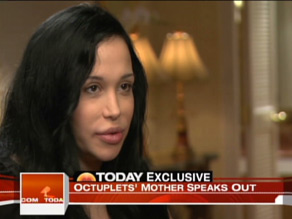Six embryos?! How to avoid a fertility fiasco
- Story Highlights
- Birth of octuplets in late January turned unflattering spotlight on fertility clinics
- Many are asking why a doctor would implant six embryos in woman under 35
- Compare a prospective fertility clinic's stats with national average on CDC Web site
- Visit online forums and discussion boards for information on fertility doctors
- Next Article in Health »
CNN Senior Medical Correspondent
Dr. Jane Miller remembers the first -- and the last -- time she implanted four embryos into a patient getting in-vitro fertilization.

Nadya Suleman gave birth to octuplets on January 26. Fanfare -- and controversy -- were not far behind.
"It was 1999, and we got triplets, and I said, 'My God, never again,' " remembers the fertility expert in Englewood Cliffs, New Jersey. "The human uterus is meant to carry only one at a time."
Since then, Miller says, she implants only one or two embryos; on "very, very rare" occasions she'll implant three. When she heard Nadya Suleman, the mother of octuplets in California, say her doctor had implanted six embryos, she was outraged.
Miller is not alone. Fertility experts around the country say there's never a reason to implant six embryos. It's risky, and it's way outside the scope of normal practice: Data from the Centers for Disease Control show that on average, fertility doctors implant 2.3 embryos into women under age 35.
Why, then, did Suleman's doctor implant so many embryos? Visit CNNhealth.com, your connection for better living
That's the question fertility experts, bloggers and now the Medical Board of California have been asking since Suleman, age 33, gave birth to octuplets in January. In media interviews, she identified her reproductive endocrinologist as Dr. Michael Kamrava of West Coast IVF Clinic in Beverly Hills, California.
The state board is now investigating the "Suleman matter," according to Candis Cohen, a spokeswoman for the board. Kamrava did not return phone calls to his office from CNN. ![]() Watch more on fertility do's and don'ts »
Watch more on fertility do's and don'ts »
Don't Miss
"It's crazy," said Dr. Walid Saleh, medical director of the Sher Institute for Reproductive Medicine in Dallas, Texas, noting that implanting six embryos clearly violates guidelines set by the American Society for Assisted Reproductive Medicine, which recommends implanting no more than two embryos in a woman under 35. "I don't know of anyone else who does this."
Saleh and other fertility experts say they think they know why Kamrava chose to implant so many embryos. The CDC keeps statistics on fertility doctors and their success rates, and Kamrava's is significantly below the national average.
Nationally, when doctors implant embryos, they manage to achieve a live birth 38.7 percent of the time, according to the CDC data. But Kamrava achieved a live birth 10 percent of the time, according to CDC data for his clinic.
"He has terrible statistics," says Miller. Other doctors say he had to put in a large number of embryos to get any success at all.
Miller and other experts in the fertility field say it's not talked about a lot, but Kamrava is not the only one implanting such a large number of embryos. "This is not an isolated case," says Pamela Madsen, a fertility blogger and founder of the American Fertility Association. "It's more common than you might think for a patient to stumble upon a doctor who's willing to deviate from the norm." Consumer Tips Blog: What not to say to infertile friends, family
So, before you select a fertility doctor, do your homework. Start by clicking on the CDC's Fertility Clinic Reports page to find information for a fertility clinic you're interested in. Look for the line "percentage of cycles resulting in live births." This tells you how often a clinic was able to achieve a live birth, or in layman's terms, the clinic's "success rate."
Farther down, the line "percentage of pregnancies with triplets or more" lets you know how often a clinic had a pregnancy with high-order multiples. "Anything more than a singleton or twins is risky," Miller says. "Even twins have higher risks of having health and developmental problems. People go to the shopping mall and see double strollers and say, 'Oh, how cute.' They don't see the ones who aren't able to leave the house."
Health Library
You can compare an individual clinic's rates with the national average on the CDC's page with national fertility statistics..
Madsen also recommends talking to other patients about their experience with fertility doctors. The groups Resolve and Fertile Thoughts both have popular online forums and discussion boards. "If you post a doctor's name and nobody's heard of him, that's a red flag," Madsen says.

To learn more about the terms you'll hear about on these Web sites and in doctor's offices, take a look at this glossary of fertility terms.
Madsen says another sign of a good fertility doctor is one who won't yield to patients' pressure to implant a large number of embryos. "Patients really need to be aware that a doctor simply pleasing them may not actually be good medical practice," she says.
CNN's Marcy Heard and Jennifer Pifer-Bixler contributed to this report.
All About Pregnancy and Childbirth

 Sit tight, we're getting to the good stuff
Sit tight, we're getting to the good stuff